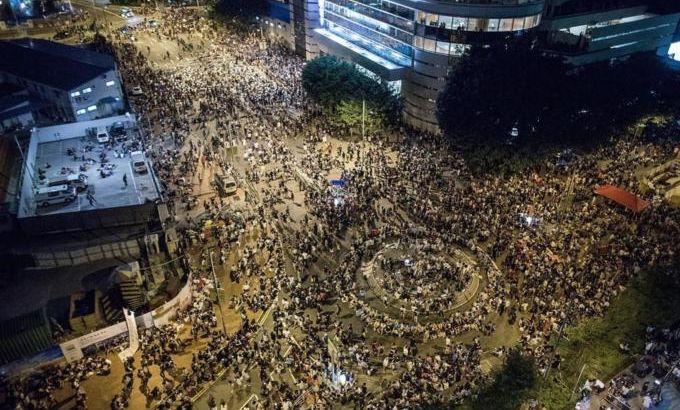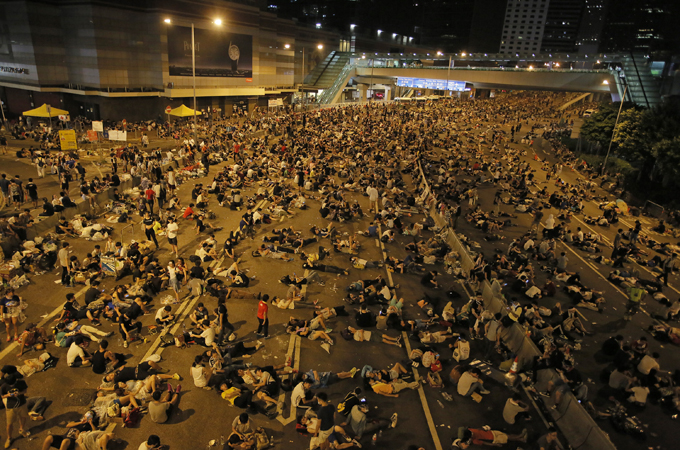Tear gas used against Hong Kong protesters
Police clash with pro-democracy demonstators as city’s leader says government to hold consultations on electoral reform.

Hong Kong police have used tear gas to disperse protesters, just after the city’s leader announced that his government will launch a new round of consultations on electoral reform shortly.
Tens of thousands of protesters had massed on major city centre highways on Sunday after a weekend of violent clashes between police and pro-democracy activists calling for greater freedoms.
Keep reading
list of 4 itemsIsraeli minister suggests reported attack on Iran was ’feeble’
Israel ‘seems determined to drag region into war’
World urges ‘de-escalation’ after drones shot down over Iran
The use of tear gas – extremely rare in Hong Kong – came after repeated pepper spray charges by helmeted police had failed to clear Harcourt Road in the Admiralty district, sparking warnings that greater force would be used.
 |
| Protesters who refused to retreat slept on Harcourt Road in Hong Kong’s Admiralty district [AP] |
Addressing a news conference, Leung Chun-ying, Hong Kong’s chief executive, said his administration was “resolute in opposing the unlawful occupation actions by Occupy Central”, branding its activities illegal as they were designed to paralyse the city’s financial district, known as Central.
Leung reassured the public that rumours the Chinese army might intervene were untrue.
“I hope the public will keep calm. Don’t be misled by the rumours. Police will strive to maintain social order, including ensuring smooth traffic and ensuring the public safety,” Leung said.
He added, “When they carry out their duties, they will use their maximum discretion”.
Leung did not provide a timeframe for the consultations.
It was his first address to protesters since students launched a demonstration on Monday to call for greater democracy and demand he meet them to discuss electoral reforms.
Student-led protests
Students and activists have been camped out on the streets outside the government complex all weekend.
The movement has grown by thousands in hours. Things have grown faster than anticipated by anybody.
The students had started the rally but by early on Sunday leaders of the broader Occupy Central civil movement said they were joining them to start a long-threatened mass sit-in.
Demonstrators barricaded themselves inside the protest zone using metal crowd control barriers originally brought in by authorities.
They donned protective gear in case police used pepper spray, wrapping their faces and arms with plastic wrap and wearing cheap plastic raincoats, goggles and surgical masks.
“The movement has grown by thousands in hours. Things have grown faster than anticipated by anybody,” Al Jazeera’s Rob McBride, reporting from the protest site, said. “Protesters are waiting for the reaction of the Beijing government.”
The latest protests escalated after demonstrators broke through a cordon late on Friday and scaled perimeter fences to invade the city’s main government compound.
The protesters reject Beijing’s recent decision to restrict voting reforms for the first-ever elections to choose the city’s leader in 2017.
Police warned those involved in what they called an illegal gathering to leave the scene as soon possible or else they would start clearing the area and making arrests.
Officers said they had arrested 78 people since demonstrations started late on Friday and warned people to stay away for their own safety.
Organisers said police took away several pro-democracy politicians.
Among the protesters was media magnate Jimmy Lai, who owns the popular Apple Daily, Hong Kong’s sole pro-democracy newspaper.
Hong Kong returned from British to Chinese rule in 1997 under a formula known as “one country, two systems” that guaranteed a high degree of autonomy and freedoms not enjoyed in mainland China. Universal suffrage was set as an eventual goal.
But China last month rejected demands for people to freely choose the city’s next leader, prompting threats from activists to shut down Central. China wants to limit elections to a handful of candidates loyal to Beijing.